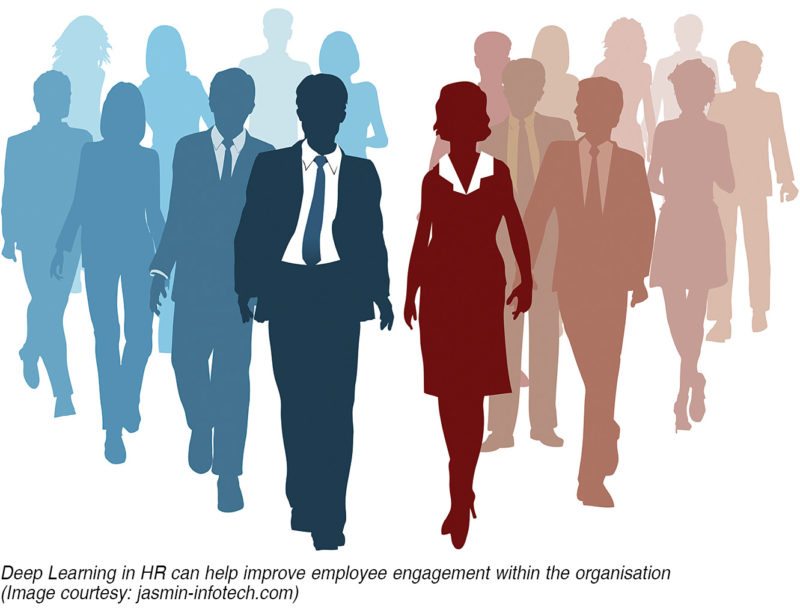- Tools like voice analysers and text analysers help decode an employee’s communication to the management.
 For a recruitment consultancy, the biggest task is finding the right match to both the recruiter and the job seeker. So one of the leading staffing agencies in India approached Bengaluru-based artificial intelligence firm EdGE Networks for a solution to create a large comprehensive database of resumes and find the right profiles for its clients. EdGE Networks suggested the use of its artificial intelligence (AI) solution HIREAlchemy, which included natural language processing, AI and predictive analytics. The outcome was outstanding.
For a recruitment consultancy, the biggest task is finding the right match to both the recruiter and the job seeker. So one of the leading staffing agencies in India approached Bengaluru-based artificial intelligence firm EdGE Networks for a solution to create a large comprehensive database of resumes and find the right profiles for its clients. EdGE Networks suggested the use of its artificial intelligence (AI) solution HIREAlchemy, which included natural language processing, AI and predictive analytics. The outcome was outstanding.
When the consultancy implemented the AI solution in its recruitment system of updating resumes from e-mails, job portals, etc, it recorded a 500 per cent increase in its resume matching capabilities. In the process, it also managed to register a whopping 2000 per cent increase in its database size.
Artificial intelligence is increasingly being recognised as an inevitable concept the world over. And while it is creating waves across industries, the human resources (HR) industry has silently started using it for substantial gains. And deep learning plays a pivotal role in it.
“We are testing the waters before AI implementation. Globally, it may have taken off in a big way but India will follow suit soon,” says an HR industry player who requested anonymity.
What’s deep learning in HR?
Currently, the most popular implementation of deep learning in HR is natural language processing. It is an intelligent system that performs tasks using natural languages of humans, including speech and texts in English. This process is extremely useful as it helps employers analyse, understand and better engage with their employees through communication.
Recruiting the right talent
Recruiters often end up hiring the wrong talent despite putting in their best efforts. Faced with a similar situation, a global IT giant based out of Bengaluru implemented deep learning systems in its HR processes. The company, which has a massive workforce and growing number of jobs, was finding it difficult to get the right candidate both externally as well as internally. Once deep learning solutions were put in place, the IT major witnessed a whopping 96 per cent reduction in the cycle time because the candidate visibility had increased by four times.
“A recruiter is expected to identify specific parameters to hire a potential employee. If the recruiter hires without a complete understanding of the core competencies of a candidate, the recruiter will not get 100 per cent quality within the time taken. Also, there will be a lack of consistency in the job role,” says Arjun Prathap, founder and CEO of EdGE Networks.
“Deep learning understands different parameters such as domain, location, certification and competency to know and select the best suited candidate for the proposed job role,” adds Prathap.
Currently, recruiters often tweak the available job description to find a candidate that best fits the job requirements. However, doing so only gives them half-baked results and often results in wastage of time, money and resources.

Enhancing employee engagement
Deep learning helps organisations understand their employees’ mindset better. Tools like voice analysers and text analysers help decode an employee’s communication to the management.
For instance, US based Madison Reed, a hair-care startup, wanted to understand whether it offered a conducive work environment to its employees, which included engineers, colourists, stylists and remote staff. So it reached out to Glint, an HR technology company, to understand the needs of its workforce. Glint’s system provided Madison Reed with real-time data, enabling its team leadership to address issues quickly and effectively. It also established a user-friendly mechanism that allowed employees to give direct and honest feedback. Monthly analytics helped the management to understand what changes in the organisation affected the employee satisfaction quotient. The system used both data analytics as well as deep learning to deliver the desired results.
Reduction in the cost to company
Deep learning mechanisms, when implemented in human resource functions of an organisation, considerably reduce expenses incurred on employees. For instance, the IT major we discussed above, witnessed a whopping 58 per cent reduction in its hiring costs. The company was also able to find the right candidate internally, thus cutting down its external hiring by almost 35 per cent.
To summarise, deep learning is a fairly new concept in the global HR industry. So you are likely to gain a first mover’s advantage by implementing machine learning in your organisation’s HR functions to make it a better workplace. After all, people are the biggest asset of any company.






